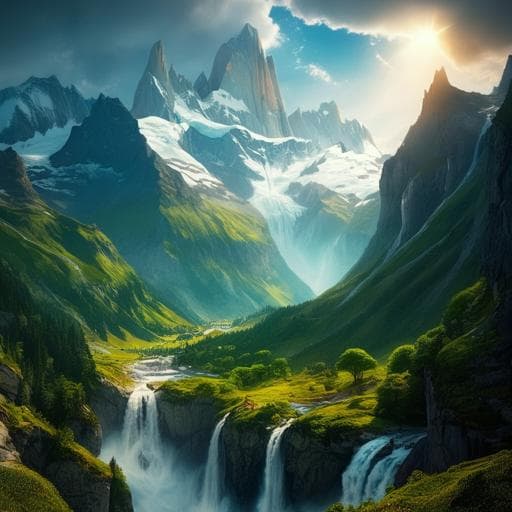
Earth Sciences
Exceptional warmth and climate instability occurred in the European Alps during the Last Interglacial period
P. S. Wilcox, C. Honiat, et al.
This groundbreaking research by Paul S. Wilcox, Charlotte Honiat, Martin Trüssel, R. Lawrence Edwards, and Christoph Spötl reveals astonishing insights into the Swiss Alps' climate during the Last Interglacial period, indicating temperatures that were up to 4.3 °C warmer than in recent decades, alongside a surprising abrupt cooling event. Explore the remarkable implications for our future climate scenarios.
~3 min • Beginner • English
Introduction
The Last Interglacial (LIG; MIS 5e, ~129–116 ka) provides a natural test bed for understanding sustained warmer-than-present climates. Prior studies in central Europe indicated summer temperatures about 1–2 °C above present, with alpine regions possibly experiencing greater warmth (~+4.3 ± 1.6 °C). Increasing evidence also points to intrinsic millennial- to centennial-scale climate variability during the LIG, but the magnitude, timing, and spatial patterns remain debated due to a paucity of independently dated, continuous, and sufficiently resolved records. Most quantitative reconstructions come from biogenic archives that can be biased and often lack robust age control, limiting temporal attribution of temperature swings. To address these gaps, this study reconstructs mean annual air temperatures across the full LIG from hydrogen isotopes (δD) of fluid inclusions in precisely U–Th-dated speleothems from two subalpine Swiss caves. High-precision δD measurements enable calculation of robust paleotemperatures. The resulting SKR-FIT record reveals temperatures up to 4.3 ± 1.4 °C above a 1971–1990 baseline and documents a 1.9 ± 1.4 °C cooling during the thermal maximum.
Literature Review
Previous central European reconstructions based primarily on pollen indicate LIG temperatures ~0–2 °C above modern at lower elevations, while a high-elevation Italian Alps speleothem record suggested +4.3 ± 1.6 °C, interpreted as elevation-dependent warming. Millennial-scale variability during the LIG has been proposed by multiple studies, yet temporal attribution is uncertain due to limited independent dating and coarse resolution. Biogenic archives can be seasonally biased and rely on vegetation–climate transfer functions or statistical models, and many lack radiometric age control. Marine records from the North Atlantic document early LIG cold events and variability, including episodes (e.g., C27) linked to meltwater discharges and potential reductions in NADW, but terrestrial evidence with precise timing has been scarce.
Methodology
Study area and samples: Speleothems were collected from two caves on the Schrattenkarst, Melchsee-Frutt region, central Switzerland (46°47′N, 8°16′E), at ~1716–1727 m a.s.l., in karstified Mesozoic carbonates with thin soil cover within the subalpine–alpine transition. Four stalagmites (M37-1-16A, M37-1-16C, M37-1-23A from Neotektonik Cave; M6-73-3 from Schratten Cave) form a stacked record growing between 132.0 ± 0.5 and 112.0 ± 0.5 ka with several short hiatuses. Mean annual air temperature near the caves is ~2.9 °C (1990–2018), mean annual precipitation ~2200 mm.
Chronology: 38 U–Th ages were measured by MC-ICP-MS (Neptune Plus) following established protocols. Ages are reported with 2σ uncertainties, and Bayesian age–depth models were constructed in OxCal 4.3 to estimate growth durations and hiatuses.
Stable isotopes: 2905 δ13C and δ18O microsamples were obtained at high spatial resolution using a micromill and measured on a ThermoFisher Delta V with GasBench II. Long-term precision is better than 0.08‰ for both δ13C and δ18O. Hendy tests were performed to assess isotopic equilibrium and fabrics documented visually.
Fluid inclusion (FI) δD measurements and temperature reconstruction: FI water was analyzed by continuous-flow, high-temperature reduction on glassy carbon. Twenty-eight calcite blocks from 16 depths (replicates at eight depths) were crushed; typical FI water yield was up to 0.86 µL (mean 0.25 µL). Replicate precision for δD is ~1.5‰ for 0.1–1 µL. Paleotemperatures were reconstructed using a modern regional precipitation isotope–temperature relationship from the GNIP station at Grimsel Pass (~24 km away, 1980 m a.s.l.). The δ18O/temperature slope is 0.65 ± 0.05‰/°C (1971–1990). A δD–T transfer function of 5.2‰/°C was derived assuming the global meteoric water line (δD = 8δ18O + 10). δD values were converted to δ18Ocalculated and then to temperature using the Grimsel slope. Only δD was used for paleotemperatures due to potential post-depositional alteration of FI δ18O and the robustness of δD in inclusions. Corrections: δD was adjusted for the LIG sea-level (ice-volume) effect at −0.064‰ per meter of sea-level rise using Red Sea core KL11; a conservative uplift correction of −0.3 °C was applied based on ~60 m post-LIG uplift and a regional lapse rate of 0.51 °C/100 m. Reference modern mean annual air temperature (MAAT) at Schrattenkarst for 1971–1990 is 2.1 °C (from Grimsel Pass lapse rate). A transfer function range of 0.6–0.7‰/°C was evaluated to capture uncertainty. Uncertainties include isotope measurement error, slope uncertainty, and standard deviation of repeats, propagated through all steps and between sampling levels.
Validation: Holocene FI data from a subrecent stalagmite (M6-1-20) yielded 2.0 ± 1.4 °C at 2.8 ± 0.2 ka and 4.4 ± 0.3 ka, consistent with the modern MAAT (2.1 °C) and independent regional constraints, supporting the approach.
Key Findings
- The SKR-FIT record shows LIG temperatures up to 4.3 ± 1.4 °C above the 1971–1990 reference period at the study elevation in the Swiss Alps.
- Two warm intervals constitute the thermal maximum: 127.3 ± 0.7 to 125.9 ± 0.5 ka, and 124.6 ± 1.0 to 124.1 ± 0.5 ka, with median anomalies of ~+3.6 ± 1.4 °C and peaks up to +4.3 ± 1.4 °C.
- Early rapid warming of ~4.6 °C occurs between 130.7 and 127.3 ka.
- An abrupt cooling of 1.9 ± 1.4 °C is centered at 125.5 ± 0.5 ka (cooling interval 125.8 ± 0.5 to 124.6 ± 1.0 ka), with a secondary step near 124.7 ± 0.9 ka, interrupting the thermal maximum.
- Subsequent fluctuations include a +1.4 °C rise at ~125.0 ka, a −1.0 °C drop at ~124.5 ka, a +1.6 °C rise by ~124.6 ka, followed by a −1.4 °C decrease to ~124.1 ka; thereafter, a gradual ~1 °C decline to 115.0 ka.
- Even during glacial inception (122–115 ka), temperatures remained 0.5 to 1.8 ± 0.8 °C above modern.
- The magnitude of alpine warming exceeds many low-elevation pollen-based reconstructions (0–2 °C), consistent with elevation-dependent warming and with Arctic LIG warming (4–5 °C).
- The SKR-FIT cooling aligns with North Atlantic evidence for event C27 (IRD deposition, δ18O and δ13C anomalies, SST cooling) and provides the first well-constrained central European terrestrial evidence for this event.
- A subrecent Holocene FI test yields 2.0 ± 1.4 °C, matching modern MAAT (2.1 °C), supporting the paleothermometry framework.
Discussion
The SKR-FIT record reveals exceptional early LIG warmth at high elevation in the Alps, substantially exceeding lowland pollen-based estimates, which can reflect seasonal biases and lack precise age control. Agreement within uncertainty with a high-elevation Italian Alps speleothem record supports elevation-dependent warming, implying amplified sensitivity of alpine climates to forcing. The well-dated 1.9 ± 1.4 °C cooling centered at ~125.5 ka corresponds to North Atlantic event C27, likely driven by meltwater discharges from the Greenland or remnant Laurentide ice sheets that weakened NADW ventilation. This suggests the impact of C27 extended into central Europe and may have been comparable in magnitude to the 8.2 ka event in central Europe. After ~124.1 ka, temperatures gradually declined yet remained above modern into MIS 5d, consistent with marine and pollen evidence off Iberia and modeling indicating sustained heat transport from strengthened NADW in late MIS 5e. These findings address the study’s aims by providing a precisely dated, quantitative, centennial–millennial scale alpine temperature reconstruction spanning the full LIG, documenting both peak warmth and intrinsic instability. The results are relevant for understanding potential future elevation-dependent warming and the risk of climate instability in Europe associated with Greenland Ice Sheet melt and reductions in NADW under anthropogenic forcing.
Conclusion
A new speleothem fluid inclusion temperature record from the Swiss Alps (SKR-FIT) documents LIG mean annual air temperatures up to 4.3 ± 1.4 °C above 1971–1990, punctuated by an abrupt ~1.9 ± 1.4 °C cooling at ~125.5 ka that aligns with North Atlantic event C27. The study provides the first well-constrained terrestrial central European evidence for C27 and demonstrates that high-elevation regions experienced amplified warming relative to lowlands. Temperatures remained above modern even into glacial inception, consistent with continued North Atlantic heat transport during late MIS 5e and a gradually deteriorating climate thereafter. These findings imply that mountain regions may experience amplified warming and increased climate instability in a greenhouse-forced future. Future work should expand high-elevation, precisely dated records across Europe and beyond, refine isotope–temperature transfer functions for past climates, and integrate proxy–model comparisons to constrain mechanisms linking ice-sheet melt, NADW variability, and terrestrial temperature responses.
Limitations
- Transfer function uncertainty: Paleotemperatures rely on a modern GNIP-based δ18O–temperature slope (0.65 ± 0.05‰/°C); a range (0.6–0.7‰/°C) was evaluated, but the exact LIG transfer function is unknown.
- Assumptions: Constant lapse rate, use of the global meteoric water line, and no explicit adjustments for changes in precipitation seasonality or atmospheric circulation across Termination II and the LIG.
- Temporal resolution: FI sampling provides centennial-to-millennial resolution with gaps due to hiatuses; abrupt events shorter than sampling resolution may be smoothed.
- Proxy constraints: Only δD was used for temperatures to avoid potential alteration of FI δ18O; while justified, this excludes independent dual-isotope cross-checks within inclusions.
- Corrections: Ice-volume and uplift corrections (−0.3 °C) introduce additional uncertainty; uplift magnitude since the LIG is approximated.
- Spatial representativeness: Results pertain to high-elevation central Alps; comparisons with lowland pollen records involve differing proxies and seasons; direct high-elevation pollen comparisons are lacking.
- Validation data: Holocene anchor points are limited to two mid–late Holocene ages due to insufficient water in younger layers.
Related Publications
Explore these studies to deepen your understanding of the subject.







